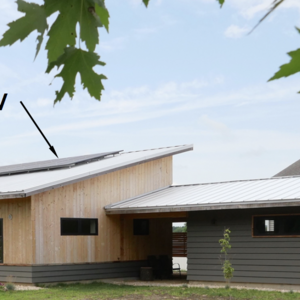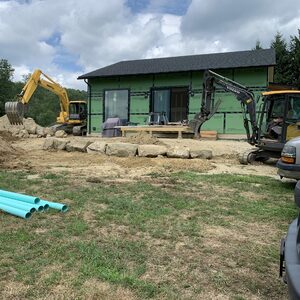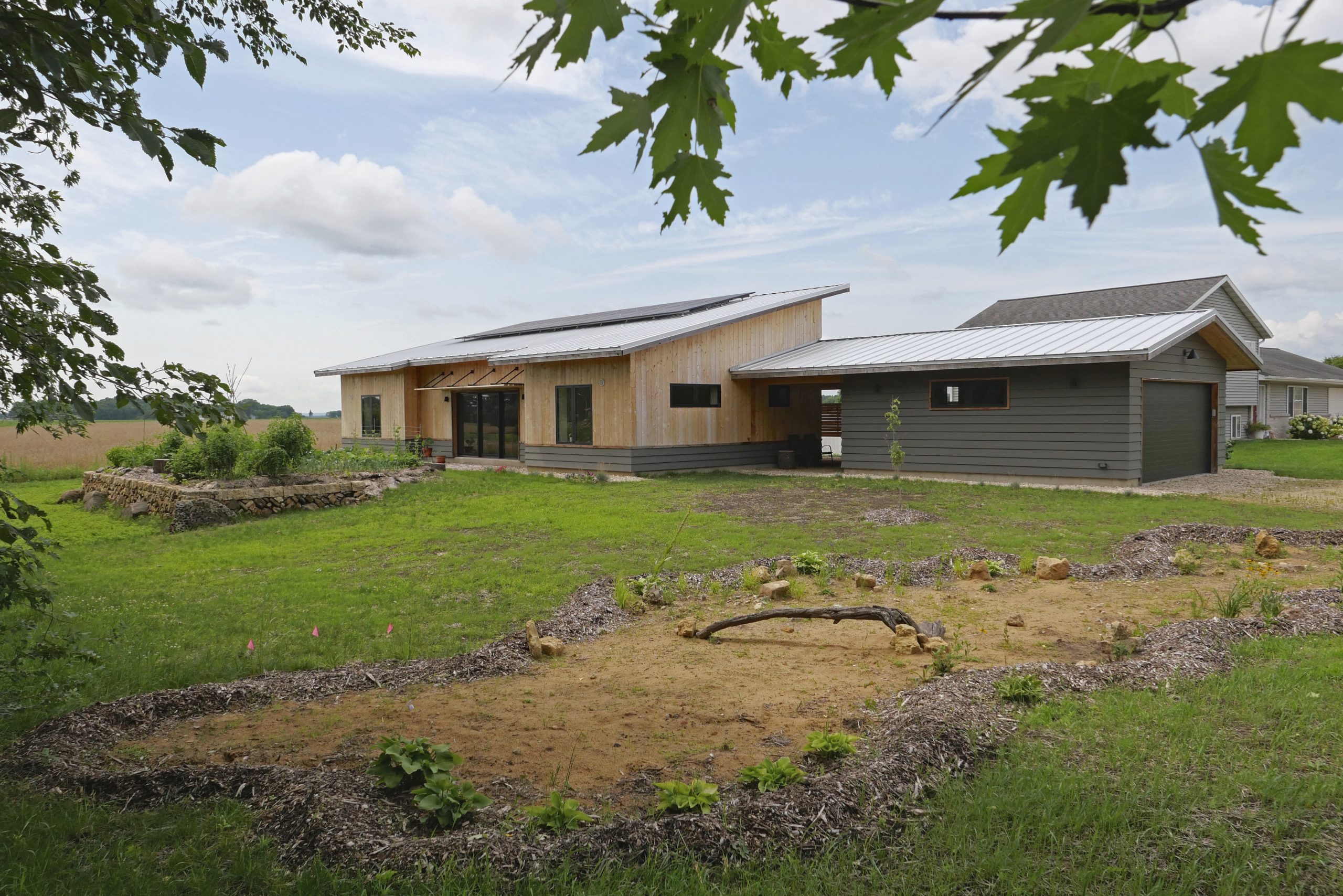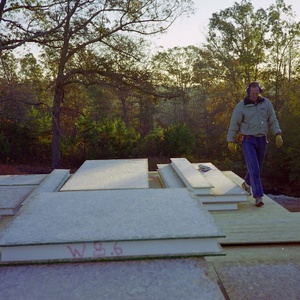
My dad, Morry, once said, “It is 100% about the money 100% of the time.” Though I believe he unleashed this observation partially in jest, it often rings true in residential construction. A client’s budget directly influences every material selection and decision made during the design and construction phases of a home build, and therefore the final cost.
Building my own home
I speak from experience as an owner/builder. My wife, Sarah, and I built this house in 2021 with a budget of $100 per sq. ft. I kept a detailed spreadsheet throughout my design process that had my estimated costs for a phase of the build, and I tracked the actual costs against that estimate. For the scope of work that I needed to hire out, I got subcontractors involved early in the process, reaching out to some key subcontractors like my excavation company, JF Trucking & Trenching, while I still lived in New York. These subcontractors were able to provide me with cost ranges that I plugged into my spreadsheet along with the material takeoffs for my self-performed scope of work.
With our design finalized and my budget spreadsheet complete in August of 2020, we secured financing via a construction loan for $250,000 for our 2750-sq.-ft. house. This $250,000 figure was based on 80% of our bank’s expected appraised value of our design at $312,500. The 80/20 loan-to-value matrix is very common in residential mortgage lending. I budgeted an additional $25,000 out of pocket, resulting in my self-design/build budget of $100 per sq. ft. As material costs steadily rose throughout the second half of 2020 and the first half of 2021, we faced a realization that to meet our budget we would either need to drastically value-engineer our interior finishes or possibly not build a portion of the project. The…
Weekly Newsletter
Get building science and energy efficiency advice, plus special offers, in your inbox.

This article is only available to GBA Prime Members
Sign up for a free trial and get instant access to this article as well as GBA’s complete library of premium articles and construction details.
Start Free TrialAlready a member? Log in















37 Comments
Congratulations! You are definitely on the path to wealth and security.
The 3000 hours of your time can be looked at as labor cost savings but
actually, are more of an insurance policy - insuring that things were done
right and that the finished product matches your preferences - in addition,
when things go wrong in the future (something always does) you will have
the knowledge and experience to find a rational minimum cost solution.
I realize that not everyone has the health, wealth, self-confidence, industriousness,
etc., to do this but I suspect that if a far greater percentage of our society tried,
we would be a much better people. GOOD LUCK!
Thank you for the kind words!
As an aspiring owner/builder, very helpful to see this detailed breakdown. I am curious about your construction loan - did the bank require that you work with a GC to receive the loan or were you able to act as a true owner/builder?
I built the house on the corner of my family farm in WI and prior to applying for project financing I took the required classes for my WI GC license and for individual certification required by the state. Once I had the business license and personal certification I moved my LLC entity from NY, where I lived for 13 years and worked as a sole proprietor, to WI. I opted to bond my LLC as opposed to going the liability insurance route since I had no plans to perform any work outside of building my house. Once I had the business entity set up I put together my full set of construction docs, including finishes, using sketch up and produced an estimate for the project. With that information in hand I approached 4 locally owned banks. One bank told me that they did not work with owner-GCs period. One bank required 50% cash down to be placed in an escrow account. One bank wanted 30% cash down. The bank that I went with, importantly was the bank that my family farm had been doing business with for multiple generations, gave me a standard line of credit style construction loan that was administered by a local title company. The construction loan had a prime +1 rate and a strict 12 month window to be converted into a mortgage. I was able to use cash on hand from the sale of our previous home to fund the site work portion of the project in order to give myself a slightly longer runway on converting the construction loan into a mortgage. Feel free to reach out to me directly at [email protected] if you have additional questions.
As mentioned, I am surprised the bank would issue a construction loan to a NON-GC, even as an owner/builder, as the bank underwriting considers it a risk for someone to take on a build like that.
I have built 2 homes, and 2 large garages, and it is not for the faint of heart. Building pre-COVID and post-COVID is like two different worlds. Pre-COVID, everything was reasonably priced, subs were easy to find and not expensive. Post-COVID, pricing was outrageous, subs were difficult to find and expensive. Labor rates doubled and even tripled since 2020. I also did a lot of things myself to save on costs and keep quality control high. The subs that get hired view you as a "one trick pony" since you will not be providing them with steady future work, so they don't give you the priority they give other projects that give them consistent and future work. So a lot of delays and canceled appointments. Plus, if you go non-conventional on the build (ICF, SIPS) that adds complexity and costs since it's harder to find someone who knows how to use those products and assemble them properly.
Good write-up and there is something to be said when you build your own home vs buying a turn-key home. It is a labor of love, sweat, blood and tears (yes, there is crying in construction). Like you, I also went over budget, which is commonplace with the ever increasing costs and outrageous inflation.
Great comments and I completely agree. The stars aligned for me to thread the "early covid" needle on pricing for both material and subs. The trades are strong in my area, especially the sole proprietors so I was able to source everyone I needed from small towns near mine. Scheduling as you mentioned is hard when you are the one trick pony and I did have delays once larger builders ramped up as the market exploded. You point about non-conventional builds is important. Most small subcontractors want nothing to do with the risks associated with the unknown.
Ian,
Nice house! I think you were also generous in including appliances in your budget, which isn't often done.
It's hard to know how transferable your numbers are for other owner-builders in that you had a big advantage of knowing how the process worked, and the skills to perform a lot of the tasks that are 0utside the abilities of those not in the industry. My experience with first time owner-builders is that the learning curve involved eats up a lot of the savings. It's also axiomatic that doing things for the first time yields poorer results than when they get done subsequently.
Malcom
I completely agree with the question of transferability. My reasons for publishing the full accounting back in 2021 was to give people a starting point in understanding the cost involved. You statement of experience with first time owner-builders makes me think back to the first home my wife and I owned in NY in 2012. I had been in the trades for a decade and was confident that I not only had the carpentry skills but also the financial savvy to organize the remodeling project on that house. Eight years, a bankruptcy near miss, tens of thousands of dollars wasted and many sleepless nights later we sold the house and embarked on building the home that I wrote about for FHB. Most importantly had I not had that humbling experience and been willing to learn from it I would have never pivoted my career focus to construction financial management. Even reading this article almost 3 years later I am struck by my naiveté when I set out to build the house. 2020 Ian knew enough to be dangerous and get the job done but 2024 Ian know a lot more about the role luck played in accomplishing this build.
Ian,
Apologies - I should have started with some comment on how useful the numbers are, rather than the caveat I posted. They are rarely published, and often unreliable in a way yours aren't.
We share a lot of common experiences. I had a fair amount of site supervision under my belt, but no hands on experience when my wife and I built our first house. Luck played a large part in its success - but it was an addictive enough experience that I pivoted from architecture to construction for decades. We built our present house thirty years ago. Hiring someone would have been beyond our budget, and it has allowed us to live in an area we now never could afford. As you say - it's also an incredibly rewarding experience - if things turn out.
Malcom
No need to apologize. And I appreciate you sharing your experience as well. The more information that we all share through channels like GBA, FHB & JLC the better off our industry is.
Thanks!
Ian
Ian,
Great article! Really appreciate you sharing the detailed cost breakdown, which as others have said, doesn't nearly get shared enough in detail. It's impressive how you managed to keep costs down even when building a high-performance house. You didn't count in your labor as a cost, but based on your 3000 hrs estimate and what I consider a reasonable billing rate, it still comes to a cost-effective $/sf in my opinion.
I'm glad to see this article after hearing about the house for years on the FHB podcast.
Thanks!
You can find the original posting and some other pieces that I wrote on FHB's website under the FHB House tab. I offered to Kiley that I could write a follow up piece now that is 3 years later. Lessons learned and updated cost data. Hopefully I can get that to Kiley soon.
Ian,
About what are the projects your company does coming in at? Here on Vancouver Island we are in the 350 to 400 a sf range.
Malcom
High performance new home builds are coming in around $500-600 sqft. What we are seeing is that the custom nature of the builds and high end finishes are the cost drivers while the high performance aspect once added to the already high cost of a custom one off build is only adding 10-15%. Remodels vary wildly with some coming in well over $1000/sqft based on a myriad of inputs.
Ian, great job!
Can you detail the DIY boiler install some? $5k is cheap! Wondering how you made that happen.
Thanks!
Paul,
Here is the material list with what I paid in 20/21 and today's price in ($).
Floor Heat 3 zone distribution panel $2000 ($3883)
https://floorheat.com/product/preassembled-3-zone-radiant-heat-distribution-control-panel-system-non-and-glycol/
Navien NCB-150E Combi Boiler $1945 (Current Model NCB-190H $2500)
Pex manifolds, Pex tubing & staple up heat fins from Pex Universe $1000 ($1500)
I worked out a deal with my plumber that I would hang the distribution panel and run all of the pex to it and he would hook the distribution panel up to the Navien Combi Boiler when he installed the gas lines and the DHW system. My wife and I ran the pex lines in the basement and garage floor and did the staple up install. The key to speeding up the process was the preassembled distribution panel.
Ian,
Congratulations and a well laid out and transparent article. There are YouTube creators that try to do this, but often blend sponsored materials into the mix. And very fortunate on the Covid price bump. Things like concrete, drywall and labor have really escalated well beyond inflation.
I'm jealous, maybe more like envious, that I'm not able to take advantage of the lower costs pre covid nor do I have the skills to offset as much labor as you did. Being a knowledgeable handy homeowner is still a ways away from being a Handyman and miles from a skilled trade. But it does give me awareness to know when not to attempt things. I'm also jealous of your local costs. I'm building in a very high cost municipality. The local utility is charging me $20,000 to run a line from the box on the street 170 ft to my electrical meter. $2,000 alone just for the "engineering design". It's outrageous, but I have no choice.
As several have already mentioned, it's hard to transfer your costs to their own situation and anyone trying this would be wise to start with a budget at least double, if not more, to account for price increases and the skilled labor you provided.
Thank you!
I agree with your assessment of doubling the budget, at least as a starting point. Depending on your location and your local market conditions. Utility and site costs being $$$ that catch many owner builders off guard. I suspect that there are still parts of the US Southeast where what I built could be done at a similar cost. Here in WI I advise people to look at what the commodity tract homes are being sold for by the bigger name builders and double their price if you want a custom home of the same size.
It is worth noting, and I will include this in the follow piece that I am writing for Kiley, that I spent 3 years planning the project before relocating back to WI to start the build. After taking my passive house training I was set on the double wall assembly but I spent a lot of time talking to mechanical contractors whom I was working with in NY & CT about the most cost effective way to spec the mechanical system for the build.
I think the important lesson is layout your costs in a systematic way during your planning stage in order to get the whole picture. And to be aware that much of what you see on YouTube and social media is nothing more than a building materials commercial masquerading as "how to" instruction.
Great write up! I'm in the process of building my own home and so far it looks like my costs are very comparable to yours. I hope to start interior work in a couple of weeks which I'm looking forward to. Only difference is that I'm doing all the work since my wife is back in school. The going price of custom homes in my area *starts* at $250/sqft and that is code minimum, so I'm looking at paying 1/3rd of that by doing so much work myself (might end up being 1/2 due to the amount of earth moving I had to do and a few other unforeseen issues).
Eric
Congrats to you for giving it a go! Feel free to reach out to me directly [email protected] if I can be of any help.
Best of luck!
Ian
> It would be easy for an observer to say that these hours need to be converted into dollars to give a true cost for the project, but I feel that this line of thinking misses the point and the spirit of self-building.
But nonetheless it's interesting to know independent of the DIY spirit.
Assuming a construction labor rate of $20-30/hr, that would add $60-90k to the price tag. Around where I live, probably $90-120k (that's what I estimate I saved by self-building a significant portion of my house). I paid for it by not having weekends or vacations for over a year though.
I think it is an integral part to a full accounting of a DIY or Owner build. But to put a dollar value to it is difficult and the "cost" varies by what the individual would have done with their time. As you said you sacrificed weekends and vacation for over a year. On our build my wife gave up her nights and weekends, her retired carpenter father was excited to have a jobsite to go to everyday and my father helped during his downtime from farming. I sacrificed some wage and 401K contributions but the sweat equity in the house more than makes up for it. There is more to the equation than swapping wage paying work for work on ones home and I appreciate that you made note of that in your comment.
> There is more to the equation than swapping wage paying work for work on ones home and I appreciate that you made note of that in your comment.
I would go even further and say part of the experience of building your own house is unquantifiable: the feeling of reflecting back to our earliest human ancestors building their own shelters.
At the same time many are interested in whether it is practical (in terms of $ vs time/effort) to self build or be hands-off.
For most people looking to save but lacking the skills/time to do work themselves, I suggest they handle their own purchases of finishing materials, instead of hiring someone to do that.
Great article. It is wonderful that you and your wife have great skills and determination. I wish more young people could do what you did........ It is a tough but rewarding experience.
As I mull over the costs you lay out so carefully, I can't help but wonder if the age of building new, standalone homes for the middle class is coming to an end as the costs seem to far outpace the ability of most families to afford them. And recent changes in several historical trends do not bode well: Cheap mortgage financing has muted the impact of rising costs until last year, but current rates are far closer to long term averages. Soft costs of home ownership (taxes, insurance, utilities) have also moved constantly upward and are unlikely to recede. Meanwhile, the huge influx of immigrant laborers over several decades has suppressed basic labor costs; but political opposition to immigration will soon probably bring this to and end so we can expect significant increases in labor costs. This at the same time skilled trades are finding it hard to replace retirees, which will drive up HVAC, plumbing and electrical costs.
As much as I love the fine craft of home building, I think we need to start thinking of meaningful alternatives if we want young families to have a chance. Perhaps it is in some form of multifamily, or manufactured housing.....I don't know.
Nick
Well said! In my role as a Production Manager and part of my company's leadership team this is something that I think about often. Not just from the sales perspective and identifying who our clients are but also the could I or the people on my team afford our services. Last statistics I remember seeing put home ownership in general out of reach for more than half the households in the US let alone tackling a custom build under the current regulatory and financial lending structures.
Thanks again for the thoughtful comments.
Ian
Thanks....Good luck with the new house!
But the average house today is basically twice the size of houses a generation ago. Homeownership is moving out of reach while we're choosing to build much more expensive homes.
I have a feeling that has more to do with how wealth is distributed across society than anything having to do with construction.
Good point. We certainly have a wealth distribution that is skewing heavily toward the top. I am not optimistic that this will improve over time, at least in the long run, as AI will probably be a huge redistribution mechanism sucking up money from the lower tiers and concentrating it more at the top.
Great article with helpful insights. Thanks for sharing your expertise Ian.
Thanks Amber!
Very insightful article, Ian. On the cost per square foot, curious if the 2750 sf is for what looks to include two floors? There appears to be a main level and walkout basement. So is the house footprint half of that 2750? Was the lower level finished out? Also, there appears to be a large garage unit behind the house. Was its cost included in the total price? I’ve always been a bit leery of comparing one house’s sf cost to another due to sometimes large discrepancies in non heated areas under roof which could include large porches, unfinished basements, and garages. I would love to see the industry come up with a type of adjusted sf cost to account for the variables. Would you mind providing the sf of your various spaces? (Finished living, basement, porches, garage). Thanks for sharing your information.
Debbie
Thank you! And great questions!
The house has a footprint of 45' x 30' = 1350 sqft per floor.
The basement level is finished and houses two on suite bedrooms and laundry in the master closet. There is a small storage area under the stair landing and the mechanical room is 120 sqft.
This is the basis for the 2700 sqft total.
The attached garage is 960 sqft.
The covered deck is 450 sqft
The covered front porch is 90 sqft.
The side deck off the kitchen is 100 sqft.
Total built sqft is 4300 sqft.
I hope this is helpful. Feel free to ask any follow up questions that you have.
Thanks, Ian. That is very helpful. I was able to plug those numbers into an opinion of cost document that I use with clients in the design stage to help with budgeting. It has about 10 levels of construction type and quality. I came up with about $600,000 as an opinion of cost if constructed by a professional builder.
As a design professional, I am very careful to encourage clients to get numbers from local builders, but sometimes early guidance is helpful esp. if their construction cost expectations are too low. Customers don't always like to share actual construction, but we did have one self-build client with construction experience whose percentage savings were not too different from yours.
We did a self-build on our last home and also had similar savings, but the reason for the self-build was that we could not find a builder who seemed to understand our desire to do some things a little differently. I can attest to the highs and lows and do not encourage self-builds as a rule. It takes a certain mindset along with construction knowledge. Your background seems to make you well-suited. So glad it turned out well for you.
Sort of a different question, but just noticed that your company builds high-performance homes so wondering if you were able to track any extra costs of above-code energy-related items?
Debbie
I ran a similar exercise to your opinion of cost document back in early 2022 when we started working with our current new home client and came up $750K for something similar to my house. I recently ran a COGS baseline for another potential high performance new home build and come up with $875-950K in COGS alone. It should be noted that my company provides the design work, management, rough carpentry and interior finish and subcontracts all of the rest. A smaller company that does all or most of the build themselves will likely have lower COGS but also a lower output of total jobs.
I am not at all surprised by the challenge you had in finding a builder willing to take the risk in doing something different. Building homes is a financially challenging high risk business and for most builders the financial risks posed by the unknown far out weight the gains.
As far as the premium cost that high performance building places on a project, I have found that one should take use the average cost of a custom build as the base and not the cost of a commodity home. Using this methodology we council would be clients that the HP premium is in the 10-15% range with a custom architect designed home being 1.5-2x that of a commodity home built by national builder.
Thanks, Ian. I would not have thought close to $900,000. So that means your savings were much larger when compared to your $341,000 actual cost, unless you were referring to an architect-designed home of equivalent size. I'd like to think that our designs are more modest (my first long-term client was a production builder), but still they are custom designs!
Thanks again for sharing your cost info, and introducing me to the term "commodity home".
Ian,
That's a very important detail and shows why comparing cost on a sqft basis requires context. Here the convention is above grade livable area without basement, garages, porches and decks. So for your place we would use 1,350 sqft and the build cost would come out at $253 per sqft, which is still outstanding. Then we have to use judgement on the number based on two storey vs bungalow , finished basement, level of finishes etc. it's really dangerous to compare builders on a cost per sqft basis because of this.
On another note, one thing you can probably do as an owner builder is to control the waste better. It's driving me crazy how contractors, especially framers waste so much material because it's faster or too much trouble. All that stuff goes to the landfill. It's just nuts and one of things in the build process that really bothers me.
I agree. One of the constant forces that we are up against in trying to build homes like this for clients is the confusion surrounding what sqft gets counted in the price. Realtors, banks and some times appraisers-both tax and sale valuation-have differing methods that make honest budgeting conversations with clients a challenge. Waste and waste management on construction projects is a challenge of a completely different sort.
Log in or become a member to post a comment.
Sign up Log in